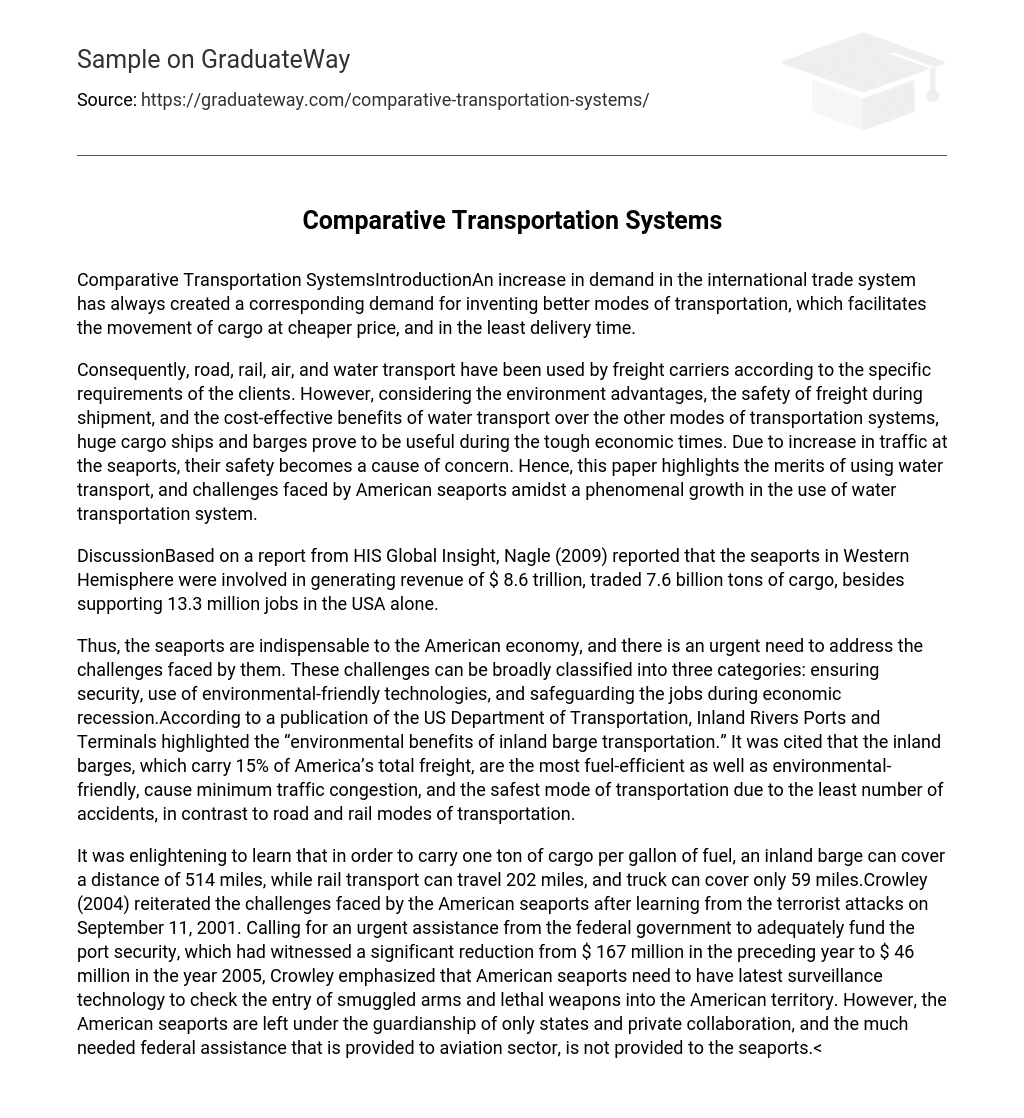Comparative Transportation SystemsIntroductionAn increase in demand in the international trade system has always created a corresponding demand for inventing better modes of transportation, which facilitates the movement of cargo at cheaper price, and in the least delivery time.
Consequently, road, rail, air, and water transport have been used by freight carriers according to the specific requirements of the clients. However, considering the environment advantages, the safety of freight during shipment, and the cost-effective benefits of water transport over the other modes of transportation systems, huge cargo ships and barges prove to be useful during the tough economic times. Due to increase in traffic at the seaports, their safety becomes a cause of concern. Hence, this paper highlights the merits of using water transport, and challenges faced by American seaports amidst a phenomenal growth in the use of water transportation system.
DiscussionBased on a report from HIS Global Insight, Nagle (2009) reported that the seaports in Western Hemisphere were involved in generating revenue of $ 8.6 trillion, traded 7.6 billion tons of cargo, besides supporting 13.3 million jobs in the USA alone.
Thus, the seaports are indispensable to the American economy, and there is an urgent need to address the challenges faced by them. These challenges can be broadly classified into three categories: ensuring security, use of environmental-friendly technologies, and safeguarding the jobs during economic recession.According to a publication of the US Department of Transportation, Inland Rivers Ports and Terminals highlighted the “environmental benefits of inland barge transportation.” It was cited that the inland barges, which carry 15% of America’s total freight, are the most fuel-efficient as well as environmental-friendly, cause minimum traffic congestion, and the safest mode of transportation due to the least number of accidents, in contrast to road and rail modes of transportation.
It was enlightening to learn that in order to carry one ton of cargo per gallon of fuel, an inland barge can cover a distance of 514 miles, while rail transport can travel 202 miles, and truck can cover only 59 miles.Crowley (2004) reiterated the challenges faced by the American seaports after learning from the terrorist attacks on September 11, 2001. Calling for an urgent assistance from the federal government to adequately fund the port security, which had witnessed a significant reduction from $ 167 million in the preceding year to $ 46 million in the year 2005, Crowley emphasized that American seaports need to have latest surveillance technology to check the entry of smuggled arms and lethal weapons into the American territory. However, the American seaports are left under the guardianship of only states and private collaboration, and the much needed federal assistance that is provided to aviation sector, is not provided to the seaports.
Due to neglect of security of American seaports, they are vulnerable to a terrorist attack, whose consequences could be worse than the 9/11 attack.ConclusionThe American seaports not only provide a safe sea-route for carrying freight into the American territory but also generate revenue for the nation’s economy by facilitating international trade. Moreover, water transportation is the most fuel-efficient and environmental friendly mode of transportation in comparison to road, rail and aviation systems. However, due to lack of federal attention and financial assistance, the seaports lack adequate security, face the tough task to guarantee a clean environment by checking emissions from the sailing vessels, and strive to sustain employment of workers in a tough time of economic recession.
ReferencesCrowley, P.J. (2004). Making our ports a priority.
Center for American Progress. Retrieved fromhttp://www.americanprogress.org/issues/2004/07/b106593.
htmlNagle, K.J. (2009) Seaports are critical to financial health. AAPA Seaports Magazine.
Retrievedfrom http://www.aapaseaports.com/article.cgi?id=16003Inland Rivers Ports and Terminals.
(n.d.). Environmental benefits of inland barge transportation.Retrieved from http://www.irpt.net/irpt.nsf/LinksView/EnvironmentalAdvantages?Opendocument





